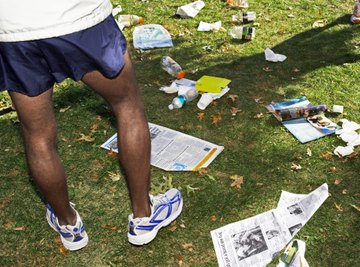
The next time you throw your Sunday newspaper in the trash, stop and think about what would happen if every household in America did the same thing. In 1995 the California Department of Conservation reported that 26 million trees per year could be saved if every Sunday newspaper were recycled. In 2011, the effects of paper waste are being felt worldwide.
Forest Devastation
Conservation of our forests is important. Our forests are disappearing at alarming rates. While many companies are adapting eco-friendly paper manufacturing processes, tissue paper companies are still cutting our Northern boreal forests. These forests are ecosystems for hundreds of species that face extinction with the disappearance of the forest habitat. Forests also contain C2O levels and produce oxygen. Tree plantations are being planted in the southeastern states to replace natural wood ecosystems. By 2040 the plantations are expected to cover 52 million acres. While providing wood, these artificial forests are not life supporting ecosystems.
Landfill Volume
According to statistics from Green Student U, 35 of every 100 pounds of waste that goes to landfills is paper. This makes paper our No. 1 waste product. Transport for waste costs money. The more waste, the more the cost to transport it. As landfill volume increases, more and more land is needed for waste containment. Wastes often need to be burned, causing air pollution. Paper contains many toxins that leak into the soil from open and covered landfills and into soil, where it causes ecological damage.
Litter
Paper constitutes over a third of all litter. It costs states as much as hundreds of thousands of dollars in clean up annually. Areas with litter problems are unattractive to tourists and businesses. Littered areas breed bacteria and attract insects and rodents, which spread the bacteria and cause illness. Paper contains toxins that seep into soil as the paper decomposes. These toxins are carried into waterways via storm water. Animals eat litter and become ill or die. Pedestrians, unsecured trucks and poorly covered trash bins are the main causes of litter.
What You Can Do
Recycling paper saves oil and energy and cuts air and water pollution. It is also an important method to save our forest ecosystems. Recycling on its own is not enough, though. Reusing paper grocery bags or using natural fiber bags instead saves trees and cuts waste and pollution. You can help control waste further by cutting down on the use of disposable paper products. Use cloth napkins instead of paper. Use edible or reusable dishes instead of paper plates or cups. Start or join cleanup and education efforts in your community. Report litterers and press for enforcement of litter laws. Each person who makes an effort to stop the waste of paper helps to save trees and ecosystems we need for survival.
References
About the Author
An honor graduate of the University of Michigan with a B.A. in English and linguistics, Sally Taylor has contracted research and writing services since 1986. She has worked with organizations such as US West AT, and SW Bell Silver Pages.
Photo Credits
Aidon/Lifesize/Getty Images
